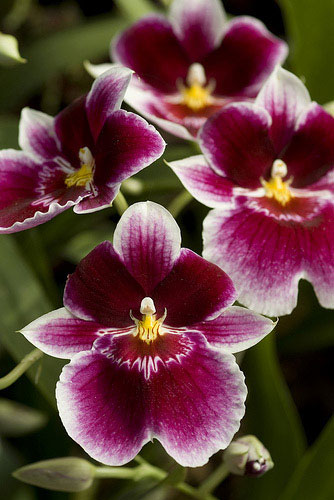When it comes to growing beautiful, vibrant flowers indoors, few options are as rewarding as the Miltonia orchid, often affectionately known as the Pansy Orchid. These stunning plants not only bring a splash of color to any room but are also safe for pets, making them a popular choice for many households. In this guide, we’ll explore the ins and outs of caring for these unique orchids, from identifying them to understanding their care needs, and addressing common issues.
Key Takeaways
- Miltonia orchids, or Pansy Orchids, are known for their vibrant colors and are safe for pets according to the ASPCA.
- These orchids thrive in indirect light, moderate temperatures, and require consistent humidity levels.
- Watering should be done weekly, allowing the soil to dry slightly between waterings.
- Common issues include black spots and ugly leaves, often due to improper watering or humidity levels.
- With proper care, Miltonia orchids can bloom multiple times a year, rewarding you with long-lasting flowers.
The Allure of Pansy Orchids: A Gardener’s Guide
The Miltonia orchid is often sought after for its striking resemblance to the pansy flower, offering a wide array of colors and patterns. Their aesthetic appeal is matched by their delightful fragrance, which can fill a room with a pleasant aroma. But beyond their beauty, these orchids hold a special place in the hearts of many gardeners because they are relatively easy to care for, once you understand their needs.
“Miltoniopsis (Pansy Orchid)” from www.orchid-care-tips.com and used with no modifications.
Pansy Orchids Overview
Pansy Orchids, scientifically known as Miltonia, are native to South America, particularly in Brazil and Colombia. They belong to a group of orchids that are characterized by their large, flat flowers that resemble pansies. Unlike some other orchid species, Miltonia orchids are known for their forgiving nature, which makes them a favorite among both novice and experienced gardeners.
Identifying Miltonia Orchids
Identifying Miltonia orchids is relatively straightforward once you know what to look for. These orchids typically have long, slender leaves and pseudobulbs, which are bulb-like structures that store water and nutrients. The flowers are usually large, with a flat, open shape and a variety of colors, including pink, purple, white, and yellow. The lip of the flower often has intricate patterns, adding to its visual appeal.
Miltonia Orchids as a Nontoxic Perennial for Pets
For pet owners, one of the most significant concerns when choosing houseplants is whether they are safe for their furry friends. Fortunately, Miltonia orchids are considered nontoxic to both cats and dogs, according to the ASPCA. This means you can enjoy the beauty of these orchids without worrying about the health of your pets.
ASPCA’s View on Nontoxic Orchids
The ASPCA (American Society for the Prevention of Cruelty to Animals) provides a comprehensive list of plants that are safe or toxic to pets. Miltonia orchids are listed as nontoxic, making them a safe choice for households with animals. This designation provides peace of mind for pet owners who want to enjoy indoor gardening without risking their pets’ health.
Why It’s Safe for Pet Owners
Miltonia orchids are safe for pet owners because they do not contain any toxic compounds that could harm animals. Unlike some other houseplants that can cause digestive issues or more severe reactions if ingested, Miltonia orchids are benign. This makes them an excellent option for anyone who wants to beautify their home without introducing potential hazards.
- Safe for horses, cats and dogs
- No harmful compounds
- Peace of mind for pet owners
Benefits of Choosing Nontoxic Plants
Choosing nontoxic plants like the Miltonia orchid offers several benefits beyond just safety. These plants allow pet owners to create a lush, green environment indoors without constant worry. Additionally, they provide an opportunity to teach children about responsible pet ownership and plant care, as they can safely interact with these beautiful flowers. For those who might struggle with pet care, there are solutions for seniors unable to care for pets that can help maintain a harmonious home environment.
Caring for Pansy Orchids: Easy or Hard?
Caring for Miltonia orchids is often considered moderately easy, provided you understand their specific needs. While they do require some attention to detail, particularly regarding light and humidity, these orchids are generally forgiving and can thrive in various indoor environments. For those looking to enhance their living space, consider exploring pet-friendly furniture options that complement your indoor garden.
Understanding Miltonia Orchid Care Needs
Miltonia orchids require a few key conditions to flourish. These include the right amount of light, temperature, and humidity. When these needs are met, the orchids will reward you with stunning blooms that can last for weeks. Let’s dive into what makes these conditions ideal.
Ideal Conditions: Light, Temperature, and Humidity
Light is crucial for the healthy growth of Miltonia orchids. They thrive in bright, indirect light, similar to the conditions they would experience in their native rainforest habitat. Too much direct sunlight can scorch the leaves, while too little light can prevent blooming.
Temperature is another important factor. Miltonia orchids prefer moderate temperatures, ideally between 65°F to 75°F (18°C to 24°C) during the day and slightly cooler at night. Extreme temperatures can stress the plant and inhibit growth.
Humidity is perhaps the most critical aspect of Miltonia orchid care. These orchids thrive in environments with high humidity, ideally around 50% to 70%. You can achieve this by using a humidity tray, misting the plant regularly, or placing it in a naturally humid room like a bathroom.
Watering and Fertilizing Essentials
Watering is one of the most critical aspects of caring for Miltonia orchids. These orchids prefer to be kept moist but not soggy. Overwatering can lead to root rot, while underwatering can cause the pseudobulbs to shrivel. The best approach is to water the plant thoroughly once a week, allowing the water to drain out completely before placing it back in its decorative pot.
Fertilizing is also important for healthy growth and blooming. A balanced orchid fertilizer, diluted to half strength, should be applied every two weeks during the growing season. In the winter months, when the plant’s growth slows, you can reduce fertilizing to once a month. This regimen ensures that the plant receives the nutrients it needs without overwhelming it.
Flowering Time and Patterns
Miltonia orchids are known for their beautiful and long-lasting blooms. Understanding their flowering patterns can help you anticipate and encourage blooms throughout the year. With proper care, these orchids can bloom multiple times a year, offering a continuous display of color and fragrance.
Typically, Miltonia orchids will bloom in the spring and fall. However, the exact timing can vary based on environmental conditions and the specific care the plant receives. By paying attention to light, temperature, and humidity, you can encourage your orchid to bloom at its best.
When to Expect Blooms
The blooming period for Miltonia orchids usually occurs in the spring and fall. During these times, the plant will produce flower spikes, which will develop into the stunning pansy-like flowers that are so characteristic of this orchid species. Each bloom can last for several weeks, providing an extended period of beauty and enjoyment.
To encourage blooming, ensure that your orchid receives the right amount of light and that the temperature remains within the ideal range. Additionally, maintaining consistent humidity levels will help the plant produce healthy flower spikes. For those who may find it challenging to care for their orchids, there are solutions for seniors unable to care for pets that can provide assistance.
Factors that Influence Bloom Duration
Several factors can influence how long Miltonia orchid blooms last. Light is one of the most critical elements; ensuring the plant receives enough indirect sunlight can extend the blooming period. Temperature also plays a role, with moderate temperatures helping to sustain blooms for longer periods. For those interested in creating a pet-friendly environment, considering these factors can be beneficial when integrating plants into your home.
Humidity is another key factor. High humidity levels help the blooms stay fresh and vibrant, preventing them from wilting prematurely. Finally, proper watering and fertilizing practices ensure the plant has the energy and nutrients it needs to support its flowers.
By carefully managing these factors, you can enjoy the stunning blooms of your Miltonia orchid for weeks at a time, bringing color and life to your home. For those interested in estate planning and ensuring your pets are cared for, learn more about pet trust law in California.
The Charm that Attracts Gardeners
Miltonia orchids have a unique charm that makes them irresistible to gardeners. Their vibrant colors, delightful fragrance, and potential for multiple blooms throughout the year make them a standout choice for anyone looking to enhance their indoor garden.
Beyond their aesthetic appeal, these orchids are relatively easy to care for, making them accessible to gardeners of all skill levels. With the right care, they can thrive and provide years of enjoyment.
Unique Beauty and Colors
The beauty of Miltonia orchids lies in their striking resemblance to pansy flowers. Their large, flat blooms come in a variety of colors and patterns, from soft pastels to vibrant, eye-catching hues. The intricate patterns on the lips of the flowers add an extra layer of visual interest, making each bloom a work of art.
Fragrance and Multi-Bloom Potential
In addition to their visual appeal, Miltonia orchids are known for their delightful fragrance. The scent is often described as sweet and floral, filling the room with a pleasant aroma that enhances the overall experience of having these orchids in your home.
- Sweet, floral fragrance
- Potential for multiple blooms per year
- Long-lasting flowers
The multi-bloom potential of Miltonia orchids means that with proper care, you can enjoy their beauty and fragrance multiple times throughout the year. This makes them an excellent choice for anyone looking to add a touch of elegance and sophistication to their indoor space.
Tackling Common Issues
While Miltonia orchids are relatively easy to care for, they are not without their challenges. Two of the most common issues that growers face are black spots on the leaves and unsightly, ugly leaves. Fortunately, both of these problems can be addressed with a little knowledge and attention to detail.
Dealing with Black Spots
- Ensure proper watering practices to prevent overwatering.
- Maintain high humidity levels to support healthy growth.
- Check for pests and treat accordingly.
Black spots on Miltonia orchid leaves are often a sign of fungal infection or pest infestation. To address this issue, it’s essential to ensure proper watering practices, as overwatering can create a breeding ground for fungi. Additionally, maintaining high humidity levels can help support healthy growth and prevent the spread of infection.
If you suspect a pest infestation, inspect the plant carefully and treat it with an appropriate pesticide. Regular monitoring and maintenance can help prevent black spots from becoming a recurring problem. For those seeking smart home devices to assist in plant care, there are innovative solutions available.
By taking these steps, you can keep your Miltonia orchid healthy and free from unsightly black spots, ensuring it remains a beautiful addition to your home.
Addressing Ugly Leaves
Ugly leaves on Miltonia orchids can result from several factors, including improper watering, low humidity, or nutrient deficiencies. To address this issue, start by evaluating your watering practices. Ensure that you are watering the plant thoroughly but allowing it to dry slightly between waterings. For those interested in how to keep their homes pet-friendly while caring for plants, check out this pet-friendly furniture guide.
Next, check the humidity levels in the room. If they are too low, consider using a humidity tray or misting the plant regularly to create a more suitable environment. Finally, ensure that the plant is receiving the necessary nutrients by following a regular fertilizing schedule.
By addressing these factors, you can help your Miltonia orchid develop healthy, vibrant leaves that complement its stunning blooms. For additional tips on maintaining a pet-friendly environment, consider checking out this pet-friendly furniture guide.
Preventing and Solving Common Problems
When it comes to Miltonia orchids, preventing common issues is all about maintaining the right conditions. The most frequent problems, such as black spots and ugly leaves, usually stem from environmental stress or improper care practices. To keep your orchids healthy, focus on providing consistent care and monitoring the plant regularly.
One effective way to prevent problems is to establish a routine for watering and fertilizing. By doing so, you ensure the plant receives the necessary nutrients and moisture it needs to thrive. Additionally, be vigilant about maintaining the right humidity levels, as this can significantly impact the overall health of your orchid.
Final Thoughts on Pansy Orchids
Miltonia orchids, with their vibrant blooms and delightful fragrance, are a rewarding addition to any indoor garden. While they require some attention to detail, the beauty they bring to your home is well worth the effort. By understanding their specific care needs and addressing common issues proactively, you can enjoy the stunning blooms of these orchids year after year.
Recommended Care Tips for Success
For the best results with your Miltonia orchids, follow these care tips:
- Provide bright, indirect light to encourage healthy growth and blooming.
- Maintain moderate temperatures and high humidity levels to replicate their natural environment.
- Water thoroughly once a week, allowing the soil to dry slightly between waterings.
- Fertilize with a balanced orchid fertilizer every two weeks during the growing season.
- Monitor the plant regularly for signs of stress or pests, and address issues promptly.
By following these guidelines, you can ensure your Miltonia orchids remain healthy and vibrant, rewarding you with their beautiful blooms.
Encouragement for Aspiring Orchid Growers
Growing Miltonia orchids can be a fulfilling and enjoyable experience for both novice and experienced gardeners. These orchids offer a unique blend of beauty, fragrance, and ease of care that makes them an excellent choice for anyone looking to expand their indoor garden.
Don’t be discouraged if you encounter challenges along the way. With patience and dedication, you can master the art of orchid care and enjoy the stunning results. Remember, the journey of nurturing these beautiful plants is just as rewarding as the blooms themselves.
Frequently Asked Questions (FAQ)
Many orchid enthusiasts have questions about the care and maintenance of Miltonia orchids. For those interested in broader plant care, you might also explore smart home devices for pet care. Here are some of the most common inquiries:
What makes Pansy Orchids safe for pets?
Pansy Orchids, or Miltonia orchids, are considered nontoxic to pets by the ASPCA. This means they do not contain harmful compounds that could pose a risk to cats or dogs if ingested, making them a safe choice for pet owners.
How often should I water Miltonia Orchids?
Miltonia orchids should be watered once a week, ensuring that the soil is thoroughly moistened. Allow the soil to dry slightly between waterings to prevent overwatering, which can lead to root rot.
What is the best potting medium for these orchids?
The ideal potting medium for Miltonia orchids is a well-draining orchid mix, often composed of bark, perlite, and sphagnum moss. This blend allows for proper aeration and drainage, supporting healthy root growth. For more detailed information, check out this Miltonia orchid care guide.
How can I prevent black spots on orchid leaves?
To prevent black spots, maintain proper watering practices and ensure high humidity levels. Regularly inspect your orchids for pests and treat any infestations promptly to prevent fungal infections that can cause black spots. For more tips on maintaining a healthy environment for your plants, consider using smart home devices to monitor conditions.
When is the best time to repot Pansy Orchids?
Repotting Miltonia orchids is best done every 1-2 years, ideally in the spring after the plant has finished blooming. This allows the plant to establish itself in fresh potting medium and encourages healthy growth.
By addressing these common questions and following the recommended care tips, you can enjoy the beauty and fragrance of Miltonia orchids in your home, creating a lush and inviting environment for both you and your pets.






